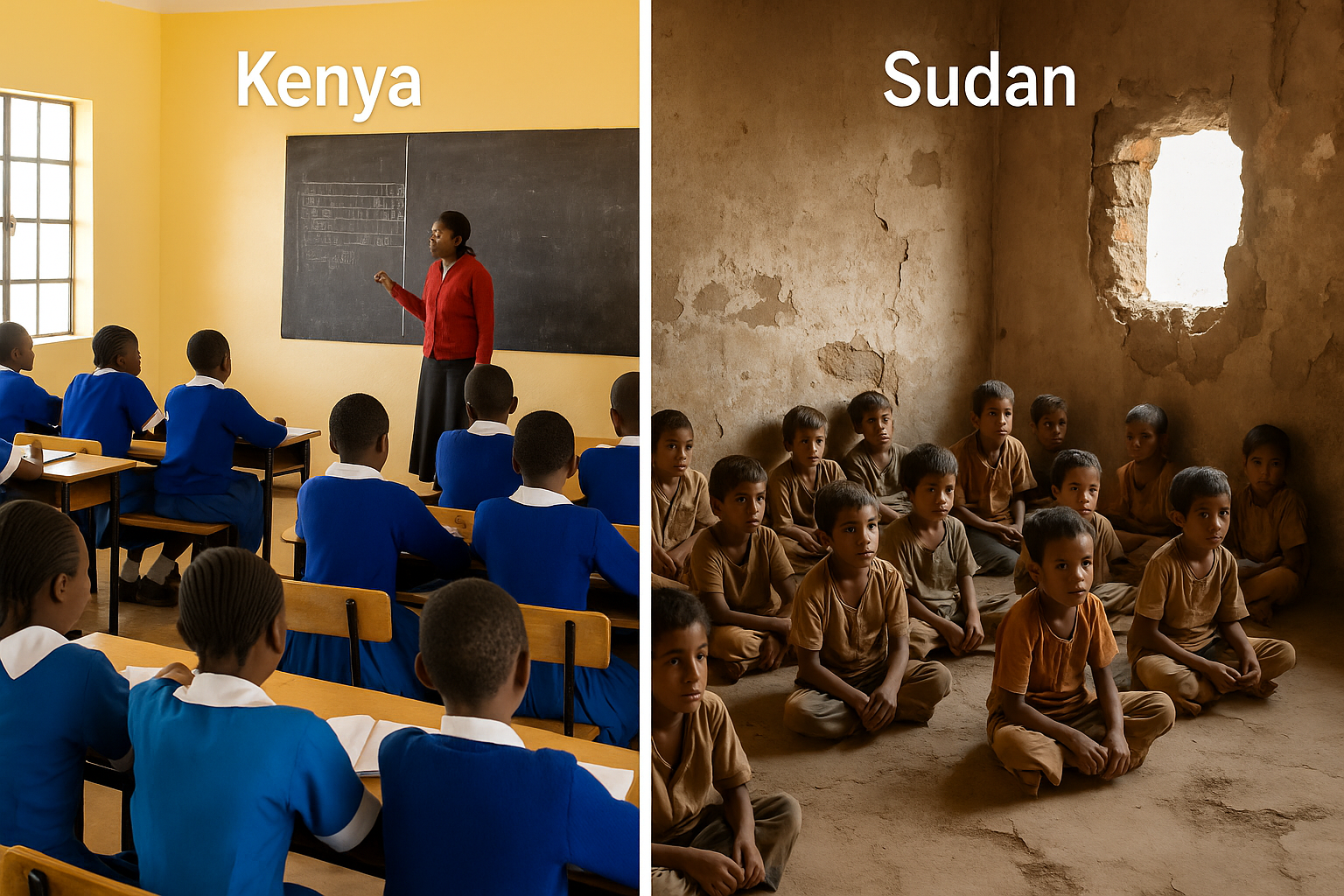Education is a fundamental human right that lays the foundation for personal growth, economic development, and societal progress. While countries across Africa strive to improve access to quality education, the experiences of nations like Kenya and Sudan reveal a stark contrast. This article explores why access to education in Kenya and Sudan differs, shedding light on the complex mix of political, economic, historical, and social factors that shape these disparities.
Historical Background of Education in Kenya and Sudan
To fully understand why access to education in Kenya and Sudan differs, it’s important to start with their colonial and post-colonial histories.
Kenya inherited a relatively structured education system from the British colonial era, which was later expanded and reformed after independence in 1963. Sudan, on the other hand, experienced prolonged periods of instability following independence in 1956, including decades of civil war and political unrest that hindered consistent educational development.
Kenya’s political environment, while not without challenges, allowed for gradual educational reforms. Sudan’s conflicts, especially in regions like Darfur and South Kordofan, have continuously disrupted access to schooling.
Government Investment and Policy Differences
One major reason why access to education in Kenya and Sudan differs is the level of government investment and policy prioritization.
Kenya introduced Free Primary Education (FPE) in 2003, which dramatically increased school enrollment. The Kenyan government consistently allocates a significant portion of its budget to the education sector, supporting infrastructure, teacher training, and learning materials.
In contrast, Sudan allocates far less funding to education. Years of political instability, economic sanctions, and leadership changes have resulted in erratic and insufficient investments in schools, particularly in rural and conflict-affected areas.
Infrastructure and Availability of Schools
Infrastructure plays a critical role in determining access to education. Here again lies a key reason why access to education in Kenya and Sudan differs.
In Kenya, while some rural regions still face shortages, many areas have access to public and private schools. Mobile schools and digital classrooms are being piloted to reach remote communities.
In Sudan, ongoing conflict has led to the destruction of school buildings and displacement of families. Many children, especially in war-torn areas, live too far from the nearest school or reside in camps where education is not consistently available.
Gender Disparities in Education Access
Another significant reason why access to education in Kenya and Sudan differs is the gender gap.
Kenya has made considerable strides in promoting girls’ education through community-based campaigns, government programs, and support from NGOs. While challenges remain, more girls are completing primary and even secondary education.
Sudan, however, continues to face cultural and religious barriers that discourage girls from attending school. Early marriages, gender-based violence, and traditional norms contribute to lower enrollment and higher dropout rates among Sudanese girls.

Impact of Conflict and Political Instability
Conflict and political instability are among the biggest barriers to education and a major reason why access to education in Kenya and Sudan differs.
Kenya has enjoyed relative peace, enabling a consistent and functional education system. Meanwhile, Sudan’s education sector has been severely damaged by internal wars, especially during the Darfur conflict and the secession of South Sudan. Many schools have been converted into shelters, and millions of children have become refugees with limited or no access to education.
Economic Factors and Poverty Levels
Poverty is another core reason why access to education in Kenya and Sudan differs, particularly in underserved regions.
In Kenya, government subsidies, school feeding programs, and the support of NGOs help alleviate financial barriers. Still, some children drop out to support their families through labor.
Sudan’s higher poverty rate makes education a luxury for many. School fees, uniforms, and learning materials are unaffordable for low-income families. Children often work to contribute to household income, reducing school attendance rates significantly.
Role of International Aid and NGOs
The effectiveness of international support is also a reason why access to education in Kenya and Sudan differs.
Kenya benefits from structured partnerships with organizations like UNICEF, World Bank, and USAID. These collaborations have funded infrastructure development, digital learning tools, and teacher training programs.
Sudan, on the other hand, relies heavily on humanitarian aid aimed at emergency response rather than long-term education development. While NGOs operate in Sudan, their work is often limited by safety concerns and government restrictions.
Literacy Rates and Educational Outcomes
Literacy rates reflect the outcomes of national education systems and provide further insight into why access to education in Kenya and Sudan differs.
As of recent data, Kenya’s adult literacy rate stands at over 80%, while Sudan’s lingers around 60%. Kenyan students are more likely to progress to secondary and tertiary levels, while many Sudanese students never complete primary school.
Such discrepancies stem from all the previously mentioned factors—policy, infrastructure, funding, conflict, and gender norms.
Bridging the Educational Gap: What Can Be Done?
Addressing why access to education in Kenya and Sudan differs requires a multi-layered approach:
- For Kenya: Continued investment in rural education, teacher quality, and curriculum relevance can help build on progress.
- For Sudan: Peace and stability must be restored first. Following that, massive investment in education infrastructure, gender-inclusive policies, and international cooperation are essential.
NGOs, governments, and communities must work together to ensure that all children, regardless of geography or background, have the opportunity to learn.
Final Thoughts
There are many reasons why access to education in Kenya and Sudan differs, including political history, government policies, conflict, poverty, gender inequality, and external aid. While Kenya continues to improve and expand its education system, Sudan faces significant hurdles that limit educational opportunities for millions of children. Bridging this gap is crucial—not just for these nations—but for the greater goal of global educational equity.
If u want to explore more must visit this : https://sourcemaui.com/

